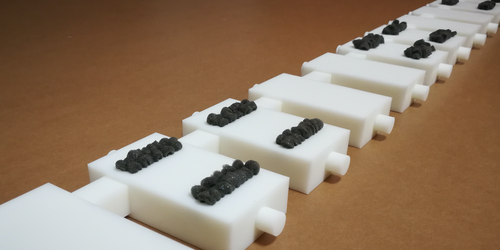Boxes Go Topological for Sound
Some materials exhibit so-called topological edge states, where they conduct light, sound, or other waves only on their surfaces or edges. Because these states robustly conduct signals regardless of external perturbations, researchers think some of these materials could be exploited to make efficient lasers. However, designing systems that sustain edge states is still an active area of research. Now a team led by Baile Zhang of Nanyang Technological University in Singapore and Jie Zhu from The Hong Kong Polytechnic University have 3D-printed boxes that, when connected in a chain, exhibit topological edge states that conduct only some frequencies of sound. The researchers say that their design could be transferred to photonics systems to make devices that conduct light in an analogous way.
The group printed twelve 3D boxes, each box roughly the size of a deck of cards, and linked them together with square rods. Skipping the initial box, they then drilled holes in the first two of every subsequent four boxes.
The group played various sound frequencies through a speaker aimed at one box in the chain and measured the system’s subsequent vibrations using a microphone aimed at that box or another. Placing the speaker at the fifth box and the microphone at the ninth, they found that the system muted a well-defined range of frequencies, which they term the band gap. But when both the speaker and microphone were aimed at the first box, they found amplifications of the band gap frequencies. The group says that their observation provides evidence of a topological edge state for the boxes. In accompanying theory, they show that the topological edge state arises from a condition known as non-Hermiticity, in which the boxes experience both gain and loss.
This research is published in Physical Review B.
–Sophia Chen
Sophia Chen is a freelance science writer based in Tucson, Arizona.




